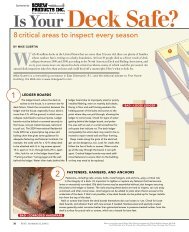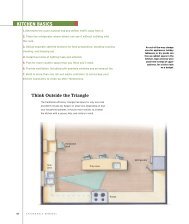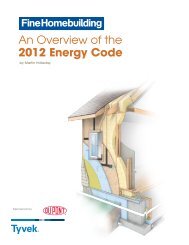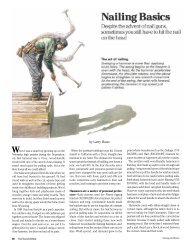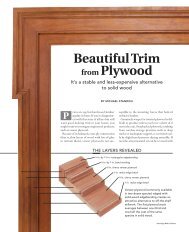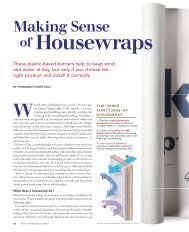Spray Polyurethane-foam Manufacturers Have A Relatively Easy
Spray Polyurethane-foam Manufacturers Have A Relatively Easy
Spray Polyurethane-foam Manufacturers Have A Relatively Easy
You also want an ePaper? Increase the reach of your titles
YUMPU automatically turns print PDFs into web optimized ePapers that Google loves.
A COLD ROOF<br />
FOR COLD CLIMATES<br />
In cold-weather climates, I create a cold roof to prevent ice<br />
dams. I do this by installing lath over the top chord, but<br />
under the roof deck. This allows the spray<br />
<strong>foam</strong> to encompass the top chord<br />
and minimize thermal<br />
24-ga. Galvalume<br />
bridging.<br />
1x4 lath<br />
—Peter Pfeiffer<br />
3 ⁄4-in. OSB<br />
2x blocking<br />
INSULATE<br />
A LEAKY<br />
BASEMENT<br />
You may recognize<br />
this approach.<br />
It’s the same one<br />
architect Betsy<br />
Pettit takes when<br />
dealing with a<br />
faulty basement<br />
wall (“Remodeling<br />
for Energy<br />
Efficiency,” FHB<br />
#194). An impermeablemembrane<br />
backed by<br />
closed-cell <strong>foam</strong><br />
channels incoming<br />
moisture to a<br />
perimeter drain in<br />
the floor.<br />
—Bruce Harley<br />
4-in. layer of<br />
crushed stone<br />
2x4 lath<br />
Perimeter drain to<br />
sump pump<br />
#30 felt<br />
2x6 truss<br />
Maximum<br />
amount of<br />
closed-cell <strong>foam</strong><br />
possible<br />
R-45 roof<br />
R-18 basement<br />
2-in. to 3-in. layer<br />
of closed-cell <strong>foam</strong><br />
2-in. to 3-in.<br />
airspace<br />
2x4 metal<br />
stud wall<br />
Roofing<br />
membrane<br />
4-in.-thick<br />
slab<br />
2-in.-thick<br />
layer of<br />
XPS <strong>foam</strong><br />
Keep <strong>foam</strong> cool. To<br />
prevent spray <strong>foam</strong><br />
from getting too hot<br />
during installation, an<br />
installer will likely fill<br />
up to 10 stud bays<br />
with a 2-in. layer of<br />
<strong>foam</strong>. By the time he<br />
reaches the tenth bay,<br />
the first bay will be<br />
cool enough for a second<br />
“lift.”<br />
be code-compliant, you can’t have <strong>foam</strong> installed thicker than what’s<br />
been approved by the ICC-ES. In a lot of homes, 4 in. of <strong>foam</strong> won’t<br />
meet insulation standards. Some manufacturers submit even thinner<br />
samples for testing because it’s easier to pass the smoke and flamespread<br />
test with thinner <strong>foam</strong> than it is with thicker samples.<br />
Not all spray <strong>foam</strong> is limited to such thin dimensions, though. <strong>Manufacturers</strong><br />
have the option of putting their <strong>foam</strong> through a full-scale<br />
test, which is equally recognized by the ICC. Full-scale tests look at<br />
<strong>foam</strong>s in thicknesses up to about 12 in. Not every manufacturer takes<br />
advantage of this option because testing is very expensive and not all<br />
<strong>foam</strong>s will be able to meet the requirement.<br />
To get the insulating value you want in a code-compliant manner,<br />
contact the <strong>foam</strong>’s manufacturer and request their evaluation-service<br />
report. More often than not, it’s available on their Web site and can be<br />
found under sections that address ASTM E84, the smoke and flamespread<br />
requirement.<br />
<strong>Manufacturers</strong> also specify how much <strong>foam</strong> can be sprayed into<br />
a cavity at a single time. In general, open-cell <strong>foam</strong> doesn’t have<br />
an application limitation and can be used to fill a cavity in a single<br />
pass. Closed-cell <strong>foam</strong>, however, must be applied in several passes,<br />
called “lifts.”<br />
Both <strong>foam</strong>s are cured by an exothermic reaction, but closed-cell<br />
<strong>foam</strong> creates a greater amount of heat as it cures and demands proper<br />
cooling time before more <strong>foam</strong> can be added to it. jim Anderson,<br />
the manager for applications and training at BASF, says, “We train<br />
our installers to spray closed-cell <strong>foam</strong> in 2-in.-thick layers and allow<br />
them to cool adequately before subsequent lifts. At 2 in., the core temperature<br />
of our <strong>foam</strong> is around 130°F to 150°F, which we feel is a<br />
safe level.” Anderson adds that there is a real danger to applying too<br />
much <strong>foam</strong> at once. “Deep applications of <strong>foam</strong> can create extremely<br />
high temperatures within the core of the insulation. Not only can the<br />
structure of the <strong>foam</strong> degrade and actually char, which will adversely<br />
affect performance, but elements within the cavity like plumbing<br />
runs, electrical wires, and boxes can also become damaged.”<br />
Be on site to be sure the job is done right<br />
Most manufacturers have extensive training programs for their<br />
installers to be sure that their spray <strong>foam</strong> is installed safely and correctly.<br />
More often than not, installers can be left alone to get the job<br />
done. But if you want to stand by and watch as the <strong>foam</strong> flies, there<br />
are a few things to look for to be sure the job is going as it should.<br />
Anderson recommends making a simple depth gauge out of wire to<br />
check <strong>foam</strong> thicknesses. He also says to be aware of off-ratio mixes in<br />
the <strong>foam</strong>, where the A and B components are unbalanced. He adds,<br />
“There should be a uniform color within each cavity. If there is a<br />
FINE HOMEBuIlDING<br />
36 Photos this page, top, and facing page, left: Courtesy of BioBased Insulation.<br />
Bottom photo, facing page: Krysta S. Doerfler.



